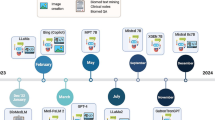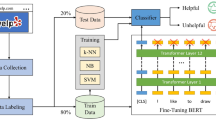Abstract
Community questions answering sites receive a huge number of questions and answers everyday. It has been observed that a number of questions among them are marked as closed by the site moderators. Such questions increase overhead of the moderators and also create user dissatisfaction. This paper aims to predict whether a newly posted question would be marked as closed in the future or not and also give a tentative reason of being closed. Two models: (1) a baseline model based on traditional machine learning techniques and (2) deep learning models such as convolutional neural network (CNN) and long short-term memory (LSTM) network are used to classify a question into one of the five classes: (1) open, (2) off-topic, (3) not a real question, (4) too constructive and (5) too localized. The baseline model requires the handcrafted features and hence does not preserve semantics. However, CNN and LSTM networks are capable of preserving the semantics of question’s word and extracting the hidden features from the textual content using multiple hidden layers. The LSTM network performs better compared to CNN and traditional machine learning models. The proposed model can be used as an initial filter to screen the closed question at the time of posting, which reduced the overheads of site moderators. To the best of our knowledge, this is the first work that predicts the closed question along with the reason the question will be closed. This helps the questioner to modify the question before posting. The experimental results with the dataset of Stack Overflow prove the effectiveness of the proposed model.























Similar content being viewed by others
Notes
Master question is the question that has similar content to the new question.
The greatest integer that is less than or equal to the value x.
References
Agichtein E, Castillo C, Donato D, Gionis A, Mishne G (2008) Finding high-quality content in social media. In: Proceedings of the 2008 international conference on web search and data mining. ACM, pp 183–194
Roy PK, Ahmad Z, Singh JP, Alryalat MAA, Rana NP, Dwivedi YK (2018) Finding and ranking high-quality answers in community question answering sites. Glob J Flex Syst Manag 19:53–68
ClosedQuestion (2018) https://stackoverflow.com/help/closed-questions. Accessed 16 Feb 2018
Correa D, Sureka A (2013) Fit or unfit: analysis and prediction of ‘closed questions’ on stack overflow. In: Proceedings of the first ACM conference on Online social networks. ACM, pp 201–212
Ahasanuzzaman M, Asaduzzaman M, Roy C K, Schneider KA (2016) Mining duplicate questions of stack overflow. In: 2016 IEEE/ACM 13th working conference on mining software repositories (MSR). IEEE, pp 402–412
Zhang Y, Lo D, Xia X, Sun J-L (2015) Multi-factor duplicate question detection in stack overflow. J Comput Sci Technol 30(5):981–997
Zhang WE, Sheng QZ, Lau JH, Abebe E, Ruan W (2018) Duplicate detection in programming question answering communities. ACM Trans Internet Technol (TOIT) 18(3):37
Krizhevsky A, Sutskever I, Hinton GE (2012) Imagenet classification with deep convolutional neural networks. In: Advances in neural information processing systems, pp 1097–1105
Hochreiter S, Schmidhuber J (1997) Long short-term memory. Neural Comput 9(8):1735–1780
Jeon J, Croft W B, Lee JH, Park S (2006) A framework to predict the quality of answers with non-textual features. In: Proceedings of the 29th annual international ACM SIGIR conference on Research and development in information retrieval. ACM, pp 228–235
Blooma MJ, Chua AY, Goh DH-L (2008) A predictive framework for retrieving the best answer. In: Proceedings of the 2008 ACM symposium on applied computing. ACM, pp 1107–1111
Toba H, Ming Z-Y, Adriani M, Chua T-S (2014) Discovering high quality answers in community question answering archives using a hierarchy of classifiers. Inf Sci 261:101–115
Wu H, Tian Z, Wu W, Chen E (2017) An unsupervised approach for low-quality answer detection in community question-answering. In: International conference on database systems for advanced applications. Springer, pp 85–101
Lee CT, Rodrigues EM, Kazai G, Milic-Frayling N, Ignjatovic A (2009) Model for voter scoring and best answer selection in community Q&A services. In: IEEE/WIC/ACM international joint conferences on web intelligence and intelligent agent technologies, 2009. WI-IAT’09, vol 1. IEEE, pp 116–123
Shah C, Pomerantz J (2010) Evaluating and predicting answer quality in community QA. In: Proceedings of the 33rd international ACM SIGIR conference on research and development in information retrieval. ACM, pp 411–418
Zhu Z, Bernhard D, Gurevych I (2009) A multi-dimensional model for assessing the quality of answers in social Q&A sites. PhD thesis
Blooma MJ, Chua AY-K, Goh DH-L (2010) Selection of the best answer in CQA services. In: 2010 Seventh international conference on information technology: new generations (ITNG). IEEE, pp 534–539
Srba I, Bielikova M (2016) Why is stack overflow failing? Preserving sustainability in community question answering. IEEE Softw 33(4):80–89
Correa D, Sureka A (2014) Chaff from the wheat: characterization and modeling of deleted questions on stack overflow. In: Proceedings of the 23rd international conference on world wide web. ACM, pp 631–642
Ponzanelli L, Mocci A, Bacchelli A, Lanza M, Fullerton D (2014) Improving low quality stack overflow post detection. In: 2014 IEEE international conference on software maintenance and evolution (ICSME). IEEE, pp 541–544
Zhang WE, Sheng QZ, Shu Y, Nguyen VK (2017) Feature analysis for duplicate detection in programming QA communities. In: International conference on advanced data mining and applications. Springer, pp 623–638
Mizobuchi Y, Takayama K (2017) Two improvements to detect duplicates in stack overflow. In: 2017 IEEE 24th international conference on software analysis, evolution and reengineering (SANER). IEEE, pp 563–564
Zhang WE, Sheng QZ, Lau JH, Abebe E (2017) Detecting duplicate posts in programming QA communities via latent semantics and association rules. In: Proceedings of the 26th international conference on world wide web. International World Wide Web Conferences Steering Committee, pp 1221–1229
Hoogeveen D, Bennett A, Li Y, Verspoor KM, Baldwin T (2018) Detecting misflagged duplicate questions in community question-answering archives. In: Twelfth international AAAI conference on web and social media, pp 112–120
Liang D, Zhang F, Zhang W, Zhang Q, Fu J, Peng M, Gui T, Huang X (2019) Adaptive multi-attention network incorporating answer information for duplicate question detection. In: Proceedings of the 42Nd international ACM SIGIR conference on research and development in information retrieval, SIGIR’19, New York, NY, USA. ACM, pp 95–104
Abric D, Clark OE, Caminiti M, Gallaba K, McIntosh S (2019) Can duplicate questions on stack overflow benefit the software development community? In: Proceedings of the 16th international conference on mining software repositories. IEEE Press, pp 230–234
Yang L, Bao S, Lin Q, Wu X, Han D, Su Z, Yu Y (2011) Analyzing and predicting not-answered questions in community-based question answering services. In: AAAI, vol 11, pp 1273–1278
Dror G, Maarek Y, Szpektor I (2013) Will my question be answered? Predicting “question answerability” in community question-answering sites. In: ECML/PKDD, vol 3, pp499–514
Asaduzzaman M, Mashiyat AS, Roy CK, Schneider KA (2013) Answering questions about unanswered questions of stack overflow. In: 2013 10th IEEE working conference on mining software repositories (MSR). IEEE, pp 97–100
Liu J, Shen H, Yu L (2017) Question quality analysis and prediction in community question answering services with coupled mutual reinforcement. IEEE Trans Serv Comput 10(2):286–301
Xia X, Lo D, Correa D, Sureka A, Shihab E (2016) It takes two to tango: deleted stack overflow question prediction with text and meta features. In: 2016 IEEE 40th annual computer software and applications conference (COMPSAC), vol 1. IEEE, pp 73–82
Rish I (2001) An empirical study of the naive Bayes classifier. In: IJCAI 2001 workshop on empirical methods in artificial intelligence, vol 3. IBM, pp 41–46
Friedman JH (2001) Greedy function approximation: a gradient boosting machine. Ann Stat 29(5):1189–1232
Liaw A, Wiener M et al (2002) Classification and regression by randomforest. R News 2(3):18–22
Cover T, Hart P (1967) Nearest neighbor pattern classification. IEEE Trans Inf Theory 13(1):21–27
Yin Z, Kong D, Shao G, Ning X, Jin W, Wang JY (2016) A-optimal convolutional neural network. Neural Comput Appl 30(7):2295–2304
Becherer N, Pecarina J, Nykl S, Hopkinson K (2017) Improving optimization of convolutional neural networks through parameter fine-tuning. Neural Comput Appl 31(8):3469–3479
Singh JP, Irani S, Rana NP, Dwivedi YK, Saumya S, Roy PK (2017) Predicting the “helpfulness” of online consumer reviews. J Bus Res 70:346–355
LeCun Y, Bengio Y, Hinton G (2015) Deep learning. Nature 521(7553):436
Pennington J, Socher R, Manning CD (2014) Glove: global vectors for word representation. In: Empirical methods in natural language processing (EMNLP), pp 1532–1543
Severyn A, Moschitti A (2015) Learning to rank short text pairs with convolutional deep neural networks. In: Proceedings of the 38th international ACM SIGIR conference on research and development in information retrieval. ACM, pp 373–382
Xu B, Wang N, Chen T, Li M (2015) Empirical evaluation of rectified activations in convolutional network. arXiv preprint arXiv:1505.00853
Collobert R, Weston J, Bottou L, Karlen M, Kavukcuoglu K, Kuksa P (2011) Natural language processing (almost) from scratch. J Mach Learn Res 12:2493–2537
Ruder S (2016) An overview of gradient descent optimization algorithms. arXiv preprint arXiv:1609.04747
Pascanu R, Gulcehre C, Cho K, Bengio Y (2013) How to construct deep recurrent neural networks. arXiv preprint arXiv:1312.6026
Jiang K, Feng S, Song Q, Calix RA, Gupta M, Bernard GR (2018) Identifying tweets of personal health experience through word embedding and LSTM neural network. BMC Bioinform 19(8):210
Lee JY, Dernoncourt F (2016) Sequential short-text classification with recurrent and convolutional neural networks. arXiv preprint arXiv:1603.03827
Zhou C, Sun C, Liu Z, Lau F (2015) A C-LSTM neural network for text classification. arXiv preprint arXiv:1511.08630
Hua Y, Zhao Z, Li R, Chen X, Liu Z, Zhang H (2019) Deep learning with long short-term memory for time series prediction. IEEE Commun Mag 57:114–119
Glorot X, Bordes A, Bengio Y (2011) Deep sparse rectifier neural networks. In: Proceedings of the fourteenth international conference on artificial intelligence and statistics, pp 315–323
Chawla NV, Bowyer KW, Hall LO, Kegelmeyer WP (2002) Smote: synthetic minority over-sampling technique. J Artif Intell Res 16:321–357
Chall JS, Dale E (1995) Manual for use of the new Dale-Chall readability formula. Brookline Books, Brookline
Kincaid JP, Fishburne RP Jr, Rogers RL, Chissom BS (1975) Derivation of new readability formulas (automated readability index, fog count and Flesch reading ease formula) for navy enlisted personnel. Technical report, DTIC Document
Author information
Authors and Affiliations
Corresponding author
Additional information
Publisher's Note
Springer Nature remains neutral with regard to jurisdictional claims in published maps and institutional affiliations.
Appendix: List of extracted textual features with their description
Rights and permissions
About this article
Cite this article
Roy, P.K., Singh, J.P. Predicting closed questions on community question answering sites using convolutional neural network. Neural Comput & Applic 32, 10555–10572 (2020). https://doi.org/10.1007/s00521-019-04592-0
Received:
Accepted:
Published:
Issue Date:
DOI: https://doi.org/10.1007/s00521-019-04592-0





